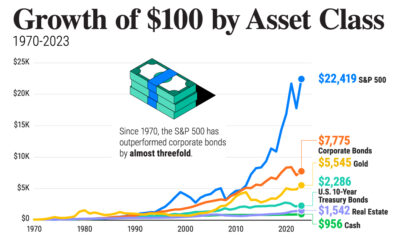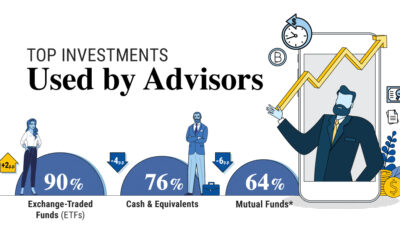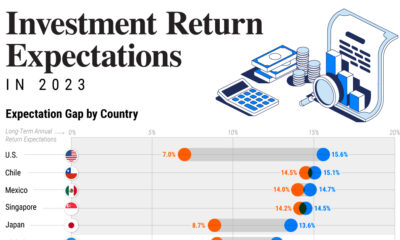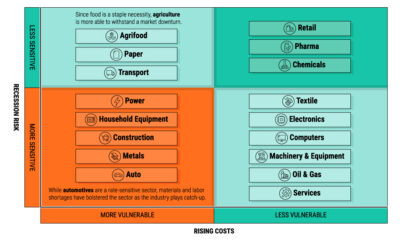This infographic is available as a poster.
Asset Class Performance After Interest Rate Hikes
For the first time in more than three years, the U.S. Federal Reserve has raised the target interest rate. It’s an incremental step towards fighting inflation that is at its highest level in 40 years. Not only that, the Federal Reserve is predicting six more interest rate hikes before the end of 2022.
What does this mean for investors and their portfolios? In this Markets in a Minute from New York Life Investments, we show the risk and return of select asset classes during the last three periods of interest rate hikes.
Historical Returns After Interest Rate Hikes
We looked at annualized returns, which measures the return investors would have earned in a year if returns were compounded. Here is how they break down, sorted from lowest average return to highest average return.
| Asset Class | Jun. 1999–
Jun. 2000 | Jun. 2004–
Jul. 2006 | Dec. 2015–
Jan. 2019 | Average |
| Municipal Bonds | 1.6% | 4.9% | 2.7% | 3.1% |
| Short-Term Bonds | 5.4% | 2.9% | 1.1% | 3.1% |
| Long-Term Bonds | 5.1% | 5.6% | 2.7% | 4.5% |
| High-Yield Bonds | -1.1% | 8.4% | 7.5% | 4.9% |
| Bank Loans | 4.2% | 5.9% | 5.2% | 5.1% |
| Large-Cap Value Stocks | -1.4% | 12.6% | 9.1% | 6.8% |
| Large-Cap Stocks | 12.1% | 8.1% | 10.9% | 10.4% |
| REITs | -0.6% | 24.4% | 8.4% | 10.8% |
| Gold | 6.7% | 24.5% | 7.2% | 12.8% |
| Large-Cap Growth Stocks | 24.7% | 3.8% | 12.3% | 13.6% |
| Ex-U.S. Developed Country Stocks | 21.6% | 21.5% | 5.5% | 16.2% |
| Global Commodities | 63.1% | 14.3% | 0.3% | 25.9% |
Based on time periods from the first Federal Reserve rate hike until one month after the last rate hike, which, on average, is when the effective federal funds rate tends to stabilize.
Among fixed income investments, floating rate bank loans had the highest average return. These loans pay a spread over a specified reference rate, with the rate resetting every 30, 60, or 90 days based on the prevailing interest rate. Because the rate “floats”, payments can rise as interest rates rise. However, bank loans are made to non-investment-grade companies, which are considered to be higher risk.
Ex-U.S. developed country stocks had the highest average return of the select stock types. International stocks may be a hedge against interest rate hikes because, compared to U.S. large cap stocks, they are more heavily concentrated in cyclical sectors like materials, industrials, and financials. These sectors tend to perform well when the economy is growing and rates are rising.
Within the alternatives realm, global commodities were the strongest on average. The average is skewed upward because of the outsized return earned in the 1999–2000 period. Brazil, Russia, India, and China were rapidly industrializing, which required an enormous amount of raw materials, food, and energy commodities. The boom lasted for more than 10 years in what is known as a commodity super cycle.
The Other Side of the Coin: Risk
We also measured asset class risk using standard deviation, which looks at the amount of variation in returns. Here is how it breaks down over the last three periods of interest rate hikes, organized from lowest to highest average risk.
| Asset Class | Jun. 1999–
Jun. 2000 | Jun. 2004–
Jul. 2006 | Dec. 2015–
Jan. 2019 | Average |
| Short-Term Bonds | 0.2% | 0.4% | 0.2% | 0.3% |
| Bank Loans | 1.9% | 0.7% | 3.0% | 1.9% |
| Municipal Bonds | 4.4% | 2.7% | 3.3% | 3.5% |
| High-Yield Bonds | 3.9% | 4.0% | 5.4% | 4.4% |
| Long-Term Bonds | 5.5% | 7.2% | 9.4% | 7.4% |
| Large Cap Stocks | 16.0% | 7.4% | 11.5% | 11.6% |
| Large-Cap Value Stocks | 16.3% | 7.2% | 11.8% | 11.8% |
| Ex-U.S. Developed Country Stocks | 14.4% | 10.6% | 11.8% | 12.2% |
| REITs | 10.9% | 13.6% | 13.8% | 12.7% |
| Large-Cap Growth Stocks | 19.4% | 8.0% | 12.2% | 13.2% |
| Gold | 20.0% | 15.6% | 12.9% | 16.2% |
| Global Commodities | 15.1% | 23.9% | 16.7% | 18.6% |
Short-term bonds had the lowest risk, and were 25 times less risky than long-term bonds on average. Bonds with shorter maturities have a lower duration—which measures the sensitivity of a bond’s price to interest rate changes—than long-term bonds. This means their prices do not drop as much when rates rise.
Among the select stocks, large cap stocks and their value style counterparts had the lowest average risk. Value stocks tend to be established companies with actual earnings, meaning they can raise prices to boost profit margins during interest rate hikes and rising inflation.
Within the alternatives realm, real estate investment trusts (REITs) had the lowest risk. Rising rates generally means the economy is growing, which translates into greater demand for real estate and the ability to charge higher rent. Interestingly, a 40-year analysis by Nareit found that REITs performed well during both high inflation and low inflation periods. This means they are less subject to prediction risk, or the risk that investors correctly predict high-inflation periods. In contrast, commodities performed well during high inflation periods but performed poorly during low inflation.
Interest Rate Hikes and Your Investments
In addition to considering the historical returns of asset classes during interest rate hikes, investors may also consider the potential risk involved.
We looked at performance within the broader categories of fixed income, stocks, and alternatives. Historically, bank loans, ex-U.S. developed country stocks, and global commodities have offered the highest average returns. However, short-term bonds, large cap stocks, and REITs had the lowest average risk.
The current macroeconomic environment, such as the Russia-Ukraine conflict, may also play a role in performance. Will history repeat itself, or will different asset classes outperform during the interest rate hikes to come?



 Infographics2 years ago
Infographics2 years ago
 Markets in a Minute2 years ago
Markets in a Minute2 years ago
 Markets in a Minute2 years ago
Markets in a Minute2 years ago
 Infographics2 years ago
Infographics2 years ago
 Markets in a Minute1 year ago
Markets in a Minute1 year ago
 Markets in a Minute2 years ago
Markets in a Minute2 years ago
 Infographics1 year ago
Infographics1 year ago
 Markets in a Minute2 years ago
Markets in a Minute2 years ago





















